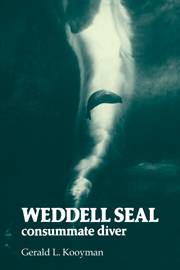Book contents
- Frontmatter
- Contents
- Preface
- Dedication
- Map
- 1 McMurdo Sound
- 2 The Weddell seal
- 3 Breeding, birth, and growth
- 4 Cold
- 5 Diving behavior: Poseidon's pride
- 6 Physiology of diving
- 7 Food habits and energetics
- 8 Under-ice orientation (summer day – winter night)
- 9 Distribution, abundance, and mortality
- 10 Future prospects
- References
- Index
7 - Food habits and energetics
Published online by Cambridge University Press: 21 May 2010
- Frontmatter
- Contents
- Preface
- Dedication
- Map
- 1 McMurdo Sound
- 2 The Weddell seal
- 3 Breeding, birth, and growth
- 4 Cold
- 5 Diving behavior: Poseidon's pride
- 6 Physiology of diving
- 7 Food habits and energetics
- 8 Under-ice orientation (summer day – winter night)
- 9 Distribution, abundance, and mortality
- 10 Future prospects
- References
- Index
Summary
Feed me with food convenient for me.
Proverbs 30:8The standard method to determine the food habits of many animals, especially those that cannot be watched while they are feeding, is to collect their stomachs and analyze the contents. Because marine mammals digest their food rapidly, the contents of their stomachs are almost always fragmented and well along in the digestive process. Consequently, the work of identification is tedious, requires much taxonomic skill, and few people are qualified for it. Because the procedure requires killing the animal, most biologists are not inclined to do this for the sake of stomach analysis only. As a result, only a few studies have been done and these were ancillary to other projects in which it was necessary to sacrifice the seal.
The most detailed study that I am aware of was done by my friend John Dearborn (Dearborn, 1965), who, as I mentioned earlier, showed me my first Weddell seal. According to John, fish occurred in about 97 percent of the stomachs of seals examined at McMurdo Sound. The species ranged from ice fish to antarctic cod, but most were antarctic smelt or belonged to a group of the genus Trematomus, for which there is no common name. Weddell seals in the Antarctic Peninsula area tend to feed more frequently on cephalopods (Bertram, 1940).
- Type
- Chapter
- Information
- Weddell SealConsummate Diver, pp. 75 - 85Publisher: Cambridge University PressPrint publication year: 1981



